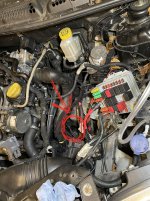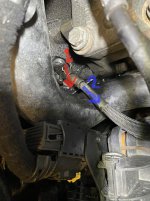Greetings all. I have gained much from this forum over the years so feel that its only right to give something back. Here is a tip I discovered (through much trial and error) whilst trying to resolve my clutch not disengaging issues. I read many of the threads on this forum and they all agreed that bleeding was a real PITA with some suggesting raising the front of the car and others saying "just stick at it"
SO in my case I had actually stripped the master cylinder to change the spring and plunger (which I did in situ by taking the bits from a new unit) and I replaced the slave cylinder with an aftermarket metal one with a proper bleed nipple. The above methods were not working well for me so I sat back and analysed the issue. The clutch piping is effectively an upside down U with a good few kinks along the way in which to trap air. The obvious route seemed to start moving the air from as close to the reservoir as possible and then push it through to the egress point at the slave. The problem lies in the fact that the master cylinder is 60 degrees inclined to the north in the car and the slave cylinder is ever slightly nose high on the gearbox.
Therefore to remedy these my recommendation is
1. Get yourself a Gunsons Quick Bleed kit or similar (as suggested on many previous threads)
2. Before attaching the bleed kit, loosen the bleed nipple on the bulkhead bleed point which resides on the bulk head behind the battery/EGR valve
3. Raise the left side of the car (not the nose) to a significant height such that the bulkhead bleed point is the highest point AND the back of the slave cylinder is also higher than its front.
4. Armed with a spare BIG foot (e.g. from Wife), a Brick or other similar heavy object push the clutch pedal down and keep it down for the entire operation.
5. Close the bulk head bleed nipple
6. Install the bleed kit, pressurise (observing pressure recommendations - I used the left front wheel as the air source)
7. Once all pressured up, armed with an 8mm spanner and a torch open the bulkhead bleed nipple in 5 second bursts until the brake fluid leaks out smoothly with no evidence of bubbles.
8. Move to the slave cylinder and do the same.
9. Once you are satisfied that all the air is out ensure the bleed nipples are sound (do NOT overtighten) and remove the self bleed kit making sure to de pressurise first.
10. Remove heavy weight from clutch pedal. You will find it stays stuck to the floor. VERY slowly lift it by hand until it is all the way to the top. Then do NOT touch it for at least 2 minutes. At this point it will be drawing in a fresh AIR FREE charge of brake fluid from the reservoir.
11. Lower car and remove jack.
At this stage, assuming you have no other leaks your systems should be air free.
Happy driving
SO in my case I had actually stripped the master cylinder to change the spring and plunger (which I did in situ by taking the bits from a new unit) and I replaced the slave cylinder with an aftermarket metal one with a proper bleed nipple. The above methods were not working well for me so I sat back and analysed the issue. The clutch piping is effectively an upside down U with a good few kinks along the way in which to trap air. The obvious route seemed to start moving the air from as close to the reservoir as possible and then push it through to the egress point at the slave. The problem lies in the fact that the master cylinder is 60 degrees inclined to the north in the car and the slave cylinder is ever slightly nose high on the gearbox.
Therefore to remedy these my recommendation is
1. Get yourself a Gunsons Quick Bleed kit or similar (as suggested on many previous threads)
2. Before attaching the bleed kit, loosen the bleed nipple on the bulkhead bleed point which resides on the bulk head behind the battery/EGR valve
3. Raise the left side of the car (not the nose) to a significant height such that the bulkhead bleed point is the highest point AND the back of the slave cylinder is also higher than its front.
4. Armed with a spare BIG foot (e.g. from Wife), a Brick or other similar heavy object push the clutch pedal down and keep it down for the entire operation.
5. Close the bulk head bleed nipple
6. Install the bleed kit, pressurise (observing pressure recommendations - I used the left front wheel as the air source)
7. Once all pressured up, armed with an 8mm spanner and a torch open the bulkhead bleed nipple in 5 second bursts until the brake fluid leaks out smoothly with no evidence of bubbles.
8. Move to the slave cylinder and do the same.
9. Once you are satisfied that all the air is out ensure the bleed nipples are sound (do NOT overtighten) and remove the self bleed kit making sure to de pressurise first.
10. Remove heavy weight from clutch pedal. You will find it stays stuck to the floor. VERY slowly lift it by hand until it is all the way to the top. Then do NOT touch it for at least 2 minutes. At this point it will be drawing in a fresh AIR FREE charge of brake fluid from the reservoir.
11. Lower car and remove jack.
At this stage, assuming you have no other leaks your systems should be air free.
Happy driving
Last edited:



